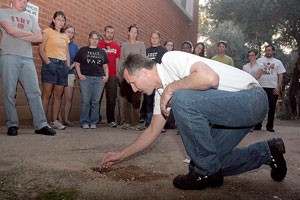Students in the Introduction to Forensic Anthropology course got a “”hands on”” lesson in crime scene investigation yesterday as they carefully dug up the real bones of a hand and arm outside the Emil W. Haury Anthropology building.
Detective Mario Leon of the University of Arizona Police Department presented the scenario as he stood behind the police tape that blocked off the mock crime scene where a bone is found by a student walking his dog on campus. Police determine that the bone is human and call the ANTH 495D/595D class to help put the pieces together, one bone at a time.
“”This is the real life CSI,”” said Francisco Baires, an anthropology graduate student, as his classmates dug around a dirty bone, wristwatch and shirt sleeve half exposed from a small hole in the ground. “”Anthropology is about getting in the dirt and finding the truth.””
Bruce Anderson, an adjunct assistant professor of anthropology, set up the mock crime scene to teach students how to work in a real crime area.
Anderson also works at the Pima County Medical Examiner’s Office, where occasionally, he works at real crime scenes similar to the one the students worked on.
“”Our job is to find out what’s in the hole and see what it can tell us,”” Anderson said. “”From the evidence we might learn if the hand was bound, if there was a gun shot wound and what interment was used to dig the hole to bury the body.””
Students conducted a thorough line search and sweep of the area, marking and measuring the evidence they found such as a cigarette butt and other bones.
“”Most classes lecture to death but this is really hands on,”” said Anka Clemmons, an anthropology junior, as she carefully measured the distance of a bone from the anthropology building. “”You can’t learn this type of stuff from a book.””
“”The real life interaction is really cool,”” said Eric Brown, an anthropology senior. “”I’m getting a vibe for what I might encounter in the field.””
The hand and arm extracted from campus yesterday were real, but were the bones of a bear, said Anderson, which has a hand bone structure similar to humans.
“”This divorces you from the misconceptions of anthropology from TV and films like CSI or Indiana Jones,”” Baires said. “”It’s not as simple as putting a bone on a computer and extracting the DNA to solve a case. In real life it’s a lot of work.””
“”CSI makes it look glamorous,”” said Kate McMahon, a non-degree seeking graduate student, as she used a screen to filter through dirt searching for pieces of remains. “”It’s a dirty and gross job digging up bones.””
“”You need to be careful at a crime scene,”” McMahon said. “”And keep your scientific integrity and not get too excited.””
For many students it was the first time they used their knowledge of anthropology and applied it to crime.
“”This shows the pivotal role that anthropology can play,”” said Zach Clark, an anthropology senior.
For students eager to get down and dirty with the class, don’t get too excited.
Forensic anthropology is usually taught every other semester, Anderson said.









